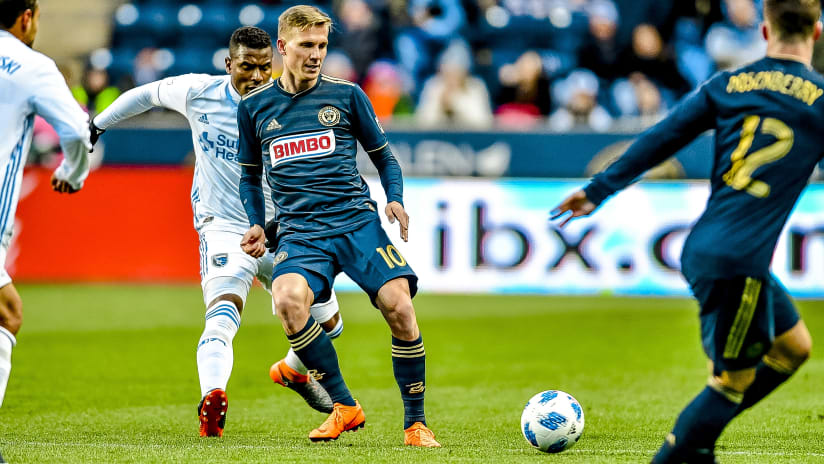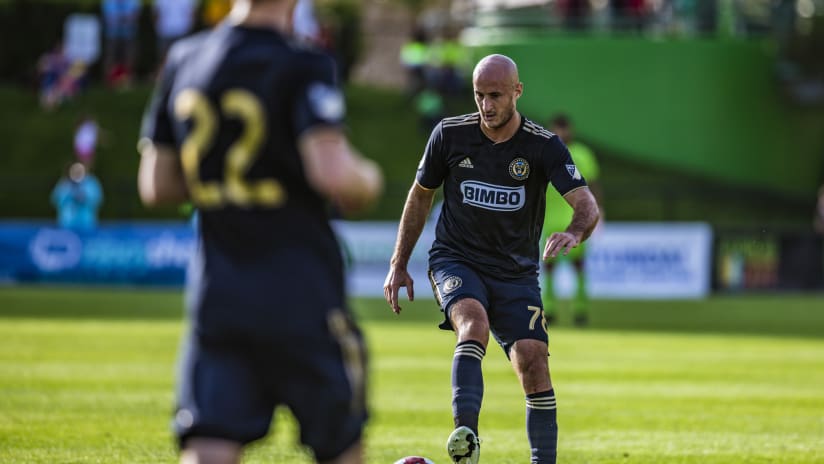In his last three games, Borek Dockal has scored a goal and added two assists twice. Sandwiched between those standout performances was a road match against New York Red Bulls, a team Jim Curtin called one of the best in the Eastern Conference. Dockal had no goals or assists, but he did make this spectacular pass.
Red Bulls had only given up two open play goals with Tim Parker and Aaron Long starting together, but Dockal’s ball made their defense look ordinary.
Furthermore, it was a pass the Union technical staff expected their new creative midfielder to make because they had seen him do it before.
In 2017, the Union used a combination of Alejandro Bedoya, Roland Alberg, and converted winger Ilsinho at the attacking midfield position. All three struggled to make consistent contributions in the role, with Bedoya eventually moving back and making the box-to-box position his own. Union fans -- including myself, writing for The Philly Soccer Page at the time -- clamored for a fix and wondered if the club recognized the need for a new creative presence.
Behind the scenes, they did.
And the key questions did not revolve around whether the team could find a new No. 10 to replace Tranquillo Barnetta, but, instead, what it was that made Barnetta effective in the Union’s system, and who could replicate and exceed that production as the system developed further.
Taking apart the 10
Traditionally, the attacking midfield position, also called the No. 10 or trequartista role, has been occupied by a technically gifted playmaker that could link defense and attack. Whether it is dribbling, passing, scoring, or, in rare cases, combinations of all three, the standout skills of an attacking midfielder were offensive, and defensive duties were secondary if required at all. As Major League Soccer has developed and grown, the No. 10 position has undergone a significant shift in responsibilities. As shifting tactics driven by Jose Mourinho and Pep Guardiola have prioritized control of the center of the pitch, playmakers have moved out of the center to find space, popping up all over the pitch to facilitate attacking third possession and create numerical advantages (e.g., 2v1s and 3v2s). Nico Lodeiro’s arrived in Seattle not as a centrally located hub of playmaking, but as a mobile, one-man space-changing circus that traveled the field searching out gaps in which to put on his impressive show.
Additionally, an emphasis on compactness out of possession has added defensive responsibilities to the attacking midfielder’s portfolio. For example, Jesse Marsch was slow to introduce Kaku to his starting eleven despite the expensive new signing’s creative potential because he felt the risk of using a player before they understood the team’s tactical system was too high. Miguel Almiron, Atlanta United’s talismanic attacker, is in the top ten in the league in both fouls suffered and fouls committed because he works from behind to dispossess opponents in midfield and instigate counterattacks.
In recent years, the Union have experienced both the old and new schools of playmaker. Cristian Maidana collected double-digit assists for Philadelphia in both 2014 and 2015. Yet, when the Union were out of possession, the man they called “Chaco” tended to hover on the periphery, positioning himself for an outlet but contributing little else as the rest of the team fought off pressure. Tranquillo Barnetta swung toward the other end of the spectrum. The Swiss midfielder and World Cup veteran turned in all-action displays, driving at defenses with the ball and chasing down opponents without it.
When Barnetta announced his intention to return St. Gallen, his hometown club, the Union were already zeroing in on the aspects of his game that had fit so well with their team and the philosophy installed under Earnie Stewart. It was just a question of finding the right man.
Volume players
When Jim Curtin and the Union technical staff talk about “volume players,” they have a very specific profile in mind. A volume player has a high usage rate, which means they make a large percentage of the passes the Union record in a game. Additionally, they absolutely must possess a key quality: Aggression. And it must be present on both sides of the ball.
Defining aggression can take many forms, but the one the Union focus on is a kind of mental aggression that drives continued progressive passing even when success is not immediate. In the Union’s possession-based attack, volume players have the freedom to take chances with forward passes behind a defense, and to take those same chances again even if they don’t come off the first time. Playing with wingers positioned high up the pitch, Philly wants to make defenders turn and face their own goal, believing that this is when mistakes are more likely to occur. So even if a throughball is cut out or cleared early in the match, a volume player must not hesitate to make the same play at a later moment. The importance of such a presence in an advanced role was driven home by the inability of Alberg and Ilsinho to replicate Barnetta’s influence on both ends of the pitch. Accurate and progressive passing are also desirable qualities for the position, along with securing a high number of ball recoveries, but those play second fiddle to that unrelenting, aggressive approach to the game.
The Union, then, did not just want a No. 10: They wanted a specific type of attacking midfielder. Barnetta was the model, but with a heavy investment in David Accam to prioritize speed on the wings, along with the turn toward a young central defense with improved distribution potential, the Swiss man was only the baseline. If the club truly believed their possession-driven system was going to evolve into something more coherent and consistent in 2018, they needed a player who could press from behind defensively and find gaps throughout the middle of the pitch so the wings could stay high. The position -- and the player that filled it -- needed to evolve as well.
Driven for Dockal
The Union identified Dockal early in the search process, and it’s easy to see why when he speaks about what he aims to do on the pitch. “To find the gaps,” Dockal stated to Philadelphiaunion.com. “To be in the spaces where I can turn with the ball and advance and find the wingers with passes in behind.”
The advanced midfielder did not just produce strong creative numbers in the Czech league, he was also a force in the Europa League against the like of Inter Milan. Dockal’s numbers were consistent across seasons both in terms of creativity and workrate, and during multiple scouting trips the Union thought he was likely to fit well with their deeper midfield core of Bedoya and Medunjanin.
Bedoya leads by example with his endless movement, and Curtin often points to Medunjanin’s dirty running as an overlooked aspect of the Bosnian’s game. This season, Dockal’s intensity has been ever-present, even when he was still feeling out his teammates during early matches. The Czech international is no luxury player, averaging around 6.5 miles of ground covered per game, which computes out to over a (American) football field per minute. For instance, when Chicago Fire tried to man-mark Dockal throughout the first half, his response was simple: “Keep running,” he said. “Because the guy that’s following you can get tired, it’s not fun for him. He can lose his concentration for a few seconds and you can try to use that.”
And as he adjusts to the league and his teammates, the offensive numbers have begun to shine through as well. In 1000 minutes of MLS action Dockal already has as many points (9) as Barnetta did in 2300 minutes in 2016, and he’s averaging almost the exact same numbers of key passes and expected assists as the Swiss midfielder did in 2016.
“It’s about spacing,” Dockal insists. “I try to move all around the pitch because I don’t want to block the spaces for my teammates.”
In short, from the range and quality of passes he can deliver down to the numbers that suggest he is playing the attacking midfield role in a similar way to Tranquillo Barnetta, Borek Dockal has been the No. 10 the Union wanted for their system, and he has played the position the way they expected him to play it.
And, taking a broader view, even Dockal’s slow start may have been overstated. Comparing his first 10 games to that of Diego Valeri you find the Argentinian at 2.53 key passes per game and Dockal at 2.54; Valeri at 0.21 expected assists and Dockal at 0.24. Valeri at 0.30 xG and Dockal at 0.22.
Looking back, fans complained: He should have arrived in 2017, or even earlier in the offseason. That part of the recruitment process, the negotiation, remains, as nearly all do, opaque.
But now that Dockal is in Philadelphia, it’s becoming clear that he has arrived to play a specific, well-defined role. And with each match he plays, Dockal is finding a rhythm that allows him to fill that role in a more productive way.
And now the Union are in the top ten in the league in shots and shots on goal per match, while holding firm in the top five in shots against as well. But perhaps more importantly, the club is seeing its philosophy brought to life on the pitch exactly the way they envisioned it. And at the heart of it all is Borek Dockal, playing exactly the way they expected.













